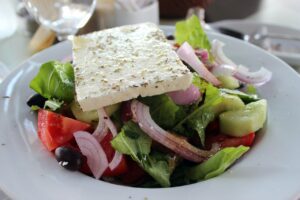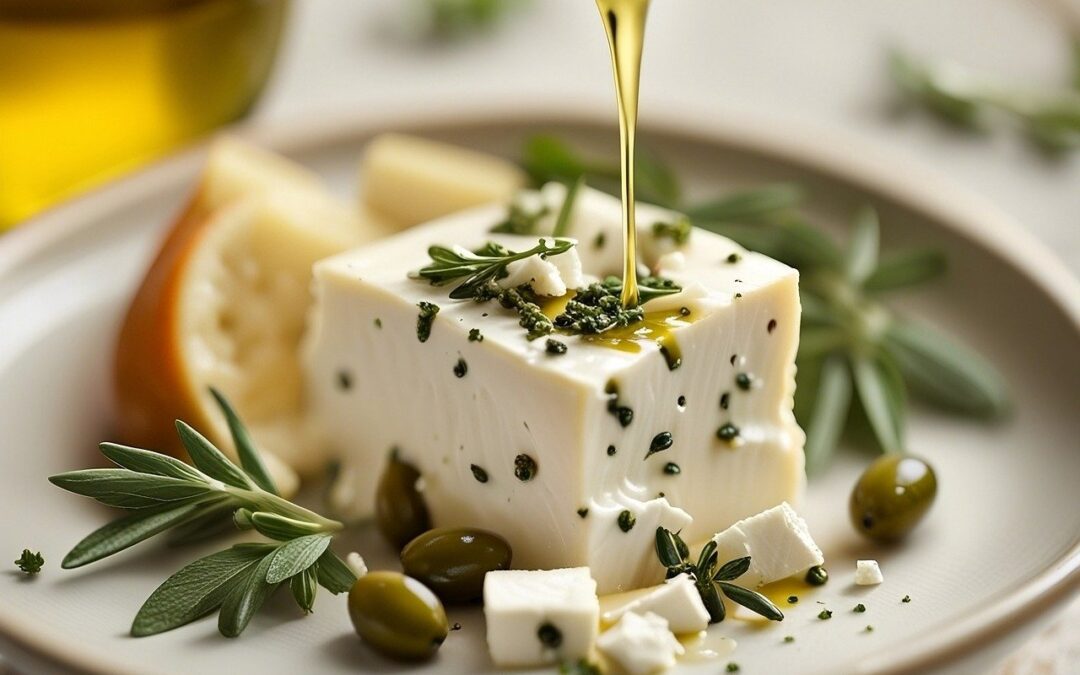By Bob Lipinski
Feta, America’s favorite Greek cheese, has been made in Greece for over 3,000 years. Although some claim the first written mention of feta appears in Homer’s Odyssey, dating to the end of the eighth century B.C.
The word feta comes from the practice of cutting the cheese into large blocks or slices (fetes) and preserving it in brine in large barrels. Before the seventeenth century, feta was just called “cheese.” The cheese’s uniqueness is attributed to the essential process of brining. Feta is known as a “pickled curd cheese” with a fresh, salty, tangy, nutty, and peppery taste due to brine soaking.
It is made with sheep’s milk, although some goat’s milk can be added. Sheep’s milk imparts a buttery richness, and goat’s milk adds acidity. The cheese has a snow white exterior and interior with small or no holes. It is brick-shaped, moist, and semisoft to firm; yet has a crumbly texture.
Feta received its PDO in 2002 and can be made in one of seven regions: specific prefectures on the mainland and on the islands of the Peloponnese, Thessalia, Epirus, Macedonia, Thrace, and Lesbos. Similar cheeses are produced in some eastern Mediterranean countries, others around the Black Sea, and the United States, with different production and aging requirements.
Interestingly, only about two percent of all feta consumed in the United States is actually made in Greece. The average Greek person consumes about 50 pounds of cheese each year, and 70 percent of the cheese eaten is feta.
Most consumers are familiar with Feta as the dry, salty, crumbly cheese, often added to a Greek salad. The majority of this cheese is U.S. made from cow’s milk and is often dyed to create the natural white color of the sheep and goat’s milk cheese.

There are many ways to enjoy Feta cheese including with cubes of watermelon, fresh mint leaves, and a balsamic glaze; a topping on pizza, focaccia, or bruschetta; with grilled baby artichokes, tomatoes, and red and green olives; and the best way — as a slab, marinated with extra-virgin olive oil, bits of black Greek olives, oregano, pepper, and salt served with pieces of crusty bread.
The Guinness World Record for the largest salad was a Greek salad made in 2016 in Moscow, Russia that weighed almost 45,000 pounds, which included two and a half tons of feta in addition to tomatoes, cucumbers, onions, olives, olive oil, oregano, and salt.
Feta has similarities to other cheeses such as Beyaz Peynir (Turkey), Brînza (Romania), Cotija (Mexico), Domiati (Egypt), Rodopa (Bulgaria), Salamura (Turkey), Sirene (Bulgaria), and Telemea (Romania).
Feta pairs well with many wines, including (whites) Assyrtiko, Chablis, Moschofilero, Pinot Gris, Riesling, and Sauvignon Blanc. (Reds) Bardolino, Gamay, Pinot Noir, Sangiovese, Valpolicella, and Zinfandel. Other beverages are Pilsner beer, champagne and sparkling wines (dry), rosé (dry), and ouzo.
Bob Lipinski is the author of 10 books, including “101: Everything You Need To Know About Whiskey” and “Italian Wine & Cheese Made Simple” (available on Amazon.com). He consults and conducts training seminars on Wine, Spirits, and Food and is available for speaking engagements. He can be reached at www.boblipinski.com OR bkjm@hotmail.com.


 Bob Lipinski, author of 10 books; writes, consults, and conducts training seminars on Wine, Spirits, and Food and is available for speaking engagements.
Bob Lipinski, author of 10 books; writes, consults, and conducts training seminars on Wine, Spirits, and Food and is available for speaking engagements.
Recent Comments